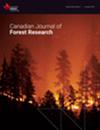辅助迁移与植物入侵:地下生态在针叶林树木生态系统中的重要性
IF 1.5
3区 农林科学
Q2 FORESTRY
引用次数: 0
摘要
本文结合地下生态这一重要的共同因素,综述了植物入侵的主要特征和辅助迁移理论。植物入侵的风险以及辅助迁移计划的潜在失败取决于调节关键生态系统过程和缓解不利环境条件的土壤微生物的存在与否。这种生物相互作用应该在造林计划选址时加以考虑,因为它与温度和降水一样重要,在决定保护和辅助迁移实践中应对气候变化。应确定真菌种类,并将其纳入气候变化减缓计划,以避免疾病爆发,并确保在选定的辅助迁移地点存在有益的互惠物种。考虑辅助迁移的植物本身存在建立困难,因此具有较低的侵入性风险。然而,真正的威胁是它们可能取代其他物种,引入病原体,或在引入点引发疾病爆发,从而使辅助迁移的努力无效。本文章由计算机程序翻译,如有差异,请以英文原文为准。
Assisted Migration and Plant Invasion: Importance of Belowground Ecology in Conifer Forest Tree Ecosystems
This paper reviews and discusses the main features of biological invasion by plants and the assisted migration theory referencing a critical common factor —belowground ecology. The risk of a plant becoming invasive, and the potential failure of assisted migration programs depend on the presence or absence of soil microorganisms that regulate key ecosystem processes and mitigate adverse environmental conditions. This biotic interaction should be considered in the selection of sites for afforestation programs since it is as important as temperature and precipitation in decisions regarding conservation and assisted migration practices in response to climate change. Fungal species should be determined and included in climate change mitigation programs to avoid disease outbreaks and ensure the presence of beneficial mutualistic species in sites selected for assisted migration. Plants considered for assisted migration should pose a low risk of becoming invasive for having establishment difficulties per se. However, the real threat is that they may displace other species, introduce pathogens, or trigger disease outbreaks in introduction sites that nullify assisted migration efforts.
求助全文
通过发布文献求助,成功后即可免费获取论文全文。
去求助
来源期刊
CiteScore
4.20
自引率
9.10%
发文量
109
审稿时长
3 months
期刊介绍:
Published since 1971, the Canadian Journal of Forest Research is a monthly journal that features articles, reviews, notes and concept papers on a broad spectrum of forest sciences, including biometrics, conservation, disturbances, ecology, economics, entomology, genetics, hydrology, management, nutrient cycling, pathology, physiology, remote sensing, silviculture, social sciences, soils, stand dynamics, and wood science, all in relation to the understanding or management of ecosystem services. It also publishes special issues dedicated to a topic of current interest.

 求助内容:
求助内容: 应助结果提醒方式:
应助结果提醒方式:


